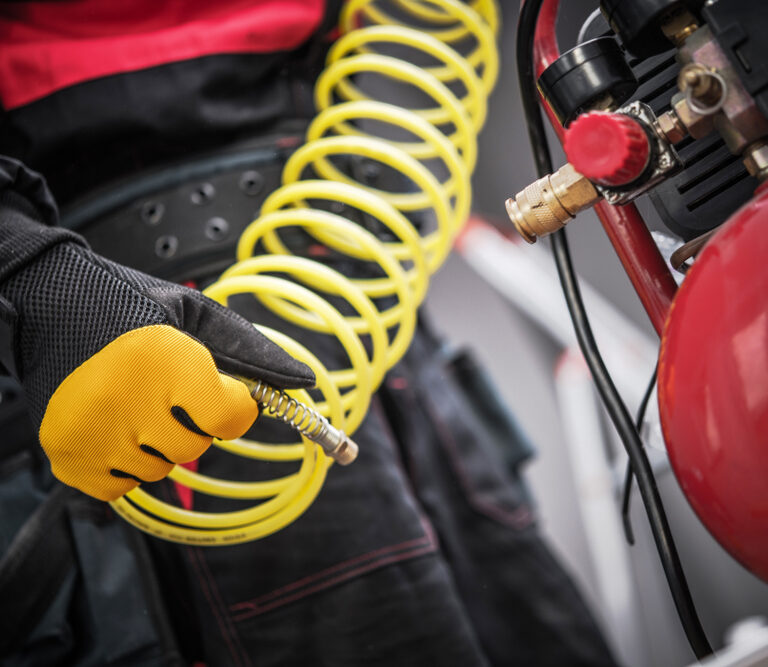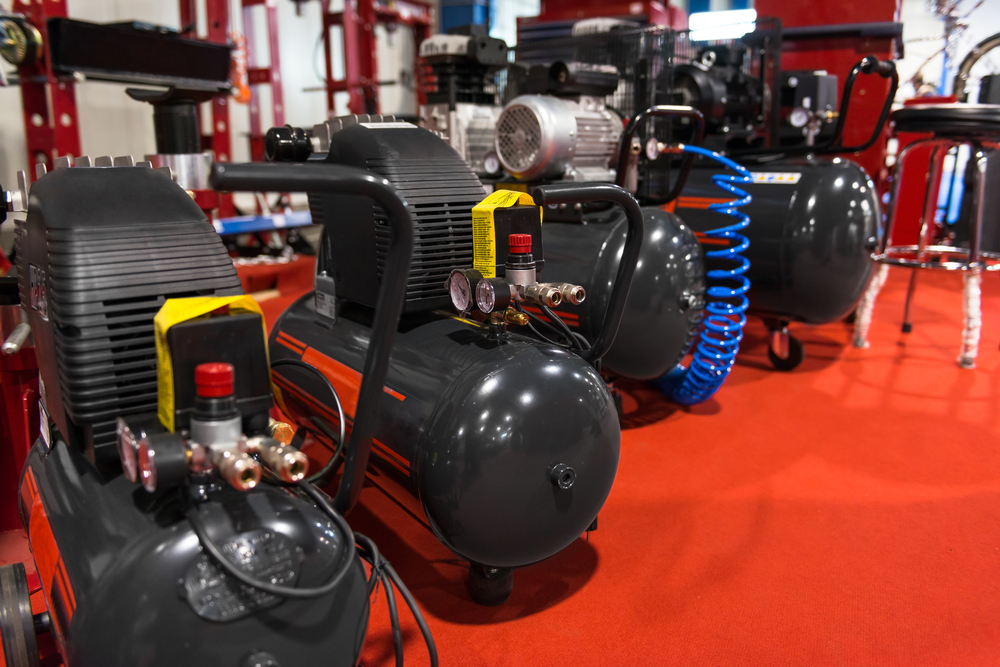Air compressors are used for many things, from inflating car tires to carrying out DIY jobs at home. The most powerful machines are large and heavy, making them difficult to store away when space is limited. This is a problem most home users face, and picking the right one can be tricky.
Whether you need a small and light air compressor for easy storage or a lower-powered unit for small tasks, we’ve got you covered.
To begin, we’ll briefly look at the most important things to consider in a small air compressor. We’ll then look at the ten best small air compressors on the market today before finally looking at the topic in more detail towards the end.
- Key Factors to Consider in a Small Air Compressor
- Top 10 Best Small Air Compressors 2023
- 1. Best Overall Pick: Craftsman Pancake Air Compressor + Accessory Kit
- 2. Best Premium Pick: Makita MAC2400 Big Bore 2.5 HP Air Compressor
- 3. Best Budget Pick: Bostitch Oil-Free Pancake Air Compressor
- 4. Smallest: Senco PC1010 Air Compressor
- 5. Quietest: California Air Tools Light & Quiet Air Compressor
- 6. Best Cordless: Dewalt Flexvolt Cordless Air Compressor Kit
- 7. Most Portable: Porter-Cable Air Compressor Kit
- 8. Honorable Mention: California Air Tools Ultra Quiet Air Compressor
- 9. Most Powerful Oil-Free Compressor: Bostitch Air Compressor for Trim
- 10. Best Vibration Dampening: Rolair JC10 Plus 1 HP Air Compressor
- Everything You Need to Know About Small Air Compressors
- Finishing Up
Key Factors to Consider in a Small Air Compressor
There are several key factors to consider when choosing the right air compressor for your needs. Below are the most important things to look out for. If you don’t have any size requirements and are looking for as much power as possible, you should also see our guide on the best air compressors to buy in 2021.
Performance
What you use the compressor for will determine the kind of performance you need. For small tasks, such as blowing out dust or inflating tires, you won’t need anything too high performance. However, for heavier jobs, such as using a sandblaster or a large impact wrench, you’ll need something a little beefier.
There are four key things to look out for when determining an air compressor’s performance. They are as follows:
- Horsepower (HP): an indication of how powerful the motor is.
- Pressure (PSI): the maximum amount of pressure the compressor can generate.
- Air Delivery (CFM): the volume of compressed air that’s delivered in one minute.
- Tank Size (Gallons): the total capacity of compressed air the tank can hold.
We discuss HP, PSI, CFM, and more in greater detail in our full air compressor guide.
In short, the best metrics to use when comparing compressors is CFM and tank size.
A higher CFM is needed for certain types of tools to ensure sufficient air delivery for the task at hand. A larger tank means you can work longer before the compressor has to kick in and refill the tank.
Design and Build Quality
The design and build quality of an air compressor will determine where it’s best suited for use. There are several different types of air compressors, each with a different design.
Some designs are more compact and lightweight, making the compressor easier to store and transport. In addition to that, some have better stability than others as they’re much wider and use rubber feet to dampen vibrations.
If you plan on using the air compressor in a harsh environment, such as on a worksite, you’ll want one that has built-in protection for the unit.
A good example is this Bostitch air compressor, as it has a solid steel frame protecting the unit from damage. Likewise, if the environment you’re working in is dusty, a fully enclosed compressor like this one from Porter-Cable would be a wise choice.
Power Source
Air compressors are either gas-powered or electric-powered. Gas-powered air compressors are more powerful than their electric counterparts, but they’re also a lot larger, heavier, and noisier.
As we’re focusing on small air compressors in this guide, we’ll only be looking at electric-powered air compressors. They’re a lot smaller, lighter, and quieter, making them ideal for light use in the home.
If you’re interested in learning more about the differences between gas and electric air compressors, take a look at our section on gas vs. electric, where we go into more detail about the pros and cons of each.
Oil-Lubricated and Oil-Free Pumps
The pump is the part of the compressor that actually pressurizes the air before storing it in the tank. There are two types of pumps out there: oil-lubricated and oil-free.
Oil-lubricated pumps run at cooler temperatures and are longer-lasting, but they do require regular maintenance. Oil-free pumps, on the other hand, don’t require maintenance and are therefore more convenient, but that does come at the expense of pump longevity.
All of the air compressors on our list, bar the Makita Big Bore, are oil-free. If you’re unsure about whether the extended pump life is worth it for the inconvenience of extra maintenance, you can read more in our full guide to pumps.
Size and Weight
And last but not least, we have the size and weight of the compressor. We’re focusing on small air compressors here, so we’ve been mindful to select only the smallest and lightest air compressors on the market.
While small and light usually means less power, the CAT Ultra Quiet is an excellent example of a small yet powerful air compressor. If you’re only carrying out small tasks at home, a smaller, lower-powered air compressor should be more than enough, although that will depend on what you’re using it for.
All of these important considerations have been highlighted in each product review, so you can see the key facts quickly and easily.
Top 10 Best Small Air Compressors 2023
1. Best Overall Pick: Craftsman Pancake Air Compressor + Accessory Kit
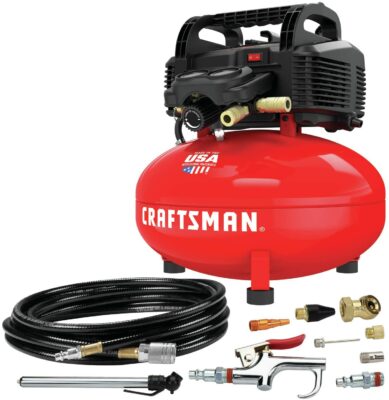
Editor’s Rating:
At a Glance
- Motor: 0.8 HP Corded Electric
- Pump: Oil-Free
- Pressure: 150 PSI Maximum
- Tank Size: 6-Gallons
- Air Delivery: 2.6 CFM @ 90 PSI
This air compressor by Craftsman features one of the largest tanks in our lineup, only matched by the budget-friendly Bostitch oil-free pancake air compressor. Thanks to its large tank and high-pressure rating, this compressor fills up quickly and delivers a good amount of air at a decent rate.
As the tank is capable of holding a larger volume of air, tools can run longer before having to recover, meaning you can get on with your work uninterrupted.
This is a pancake style compressor, giving it better stability than some of the other designs. It has three rubber feet to keep it from moving during operation. However, on smooth surfaces, the vibrations from the compressor are enough to make it move. If you’re using it on a smooth surface, you may need to anchor it down.
You’ll find a drain release valve at the bottom of the tank which must be tightened before using the compressor. It’s left open out of the factory, so it won’t hold any pressure unless it’s closed. The release valve should be opened once you’ve finished with the compressor to allow any remaining air or water to drain out. This is especially important if you live in a humid area, as there will be more moisture in the air.
This air compressor comes with a long hose that makes high up places easier to reach, in addition to plenty of accessories to get you up and running in no time. The regulator knob is easy to turn and allows you to select the exact PSI setting you need for the specific job you’re doing.
The two gauges make it easy to see the tank’s current capacity and operating PSI, allowing you to easily see how much air you have left before it needs to refill.
One downside is that it’s quite noisy when you compare it to the quieter California Air Tools air compressor. This may not be an issue for some people, but you may need to wear ear protection when using it in close proximity.
Craftsman is a well-known American brand, most famous for its high-quality garage and power tools. This compressor is made in the USA, so you know it’s built to a high standard. Considering the price, size, and performance of this small air compressor kit, we believe that it’s the best overall small air compressor to suit most people’s needs.
Pros
- Large 6-gallon capacity tank
- Excellent air delivery for a small compressor
- High-quality pressure regulator for precise PSI selection
- Accessories and hose included
- Made in the USA by an American company
Cons
- Quite noisy at 82 dB
- Vibrations cause it to move on smooth surfaces
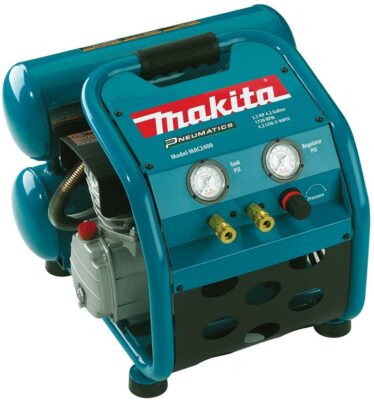
Editor’s Rating:
At a Glance
- Motor: 2.5 HP Corded Electric
- Pump: Oil-Lubricated
- Pressure: 130 PSI Maximum
- Tank Size: 4.2-Gallons
- Air Delivery: 4.2 CFM @ 90 PSI
The Makita Big Bore is the most powerful air compressor on our list, with the highest horsepower and CFM rating. This makes it a good choice for larger jobs or more frequent use, especially over longer periods of time. All of that power does come at a price, though. This is the heaviest and most expensive air compressor on our list.
This is a twin-stack style air compressor, featuring two tanks with a total capacity of 4.2-gallons. While the tank capacity is larger than most of the compressors on our list, it is smaller than the 6-gallon Bostitch.
The twin-stack design features a solid roll cage that protects the compressor in tough conditions, such as on a worksite. This design, combined with the good-sized rubber feet, makes the compressor very stable and great at dampening vibrations on any type of surface.
Unlike the rest of the air compressors on our list, the Makita Big Bore does use oil to lubricate the pump. This means there’s more maintenance required compared to the oil-free pumps. However, this results in cooler operating temperatures and reduced wear, thus increasing the lifespan of the pump. A bottle of oil is included with the compressor.
Pros
- Powerful 2.5 HP motor
- Solid construction using a roll cage for protection
- Longer lasting oil-lubricated pump
- High 4.2 CFM air delivery
Cons
- Requires maintenance as it uses oil
- Heavy at 77 pounds
3. Best Budget Pick: Bostitch Oil-Free Pancake Air Compressor
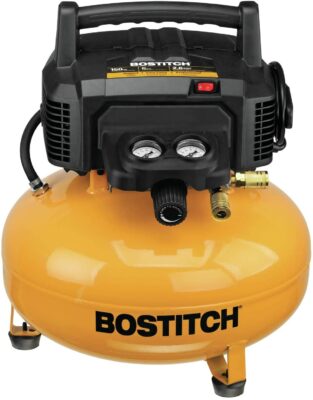
Editor’s Rating:
At a Glance
- Motor: 0.9 HP Corded Electric
- Pump: Oil-Free
- Pressure: 150 PSI Maximum
- Tank Size: 6-Gallons
- Air Delivery: 2.6 CFM @ 90 PSI
This Bostitch air compressor is very similar to our overall pick, the Craftsman pancake compressor. The key difference is in the build quality and included accessories. We feel the Craftsman has a better build quality, and it also comes as a kit. There is an option to purchase this air compressor as a kit, but it costs significantly more than the standalone unit.
This is our budget pick as it’s the cheapest air compressor we’ve looked at, while still offering excellent performance. The airflow regulator can be adjusted easily enough, although it isn’t as precise as the one on the Craftsman.
It also has two universal couplers to support up to two users at once. However, if you’re doing some heavy-duty work, it won’t be able to sustain two tools at the same time.
Design-wise it’s easy to carry and has rubber feet to help dampen vibrations, although it runs into the same issue of moving about on smooth surfaces.
This is a great value machine for home users. If this is your first time buying an air compressor and you have a limited budget, choose this one. If you can stretch your budget, we’d suggest buying the higher quality Craftsman. If the extra power isn’t so important to you, but you want a compressor that’s small, light, and quiet, take a look at the Senco PC1010.
Pros
- Budget-friendly and good value for money
- Large 6-gallon tank
- Excellent air delivery at 2.6 CFM
Cons
- Not as high quality as the very similar Craftsman
- Hose and accessories aren’t included
4. Smallest: Senco PC1010 Air Compressor
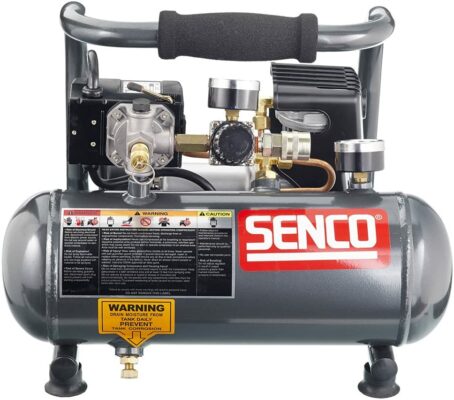
Editor’s Rating:
At a Glance
- Motor: 0.5 HP Corded Electric
- Pump: Oil-Free
- Pressure: 125 PSI Maximum
- Tank Size: 1-Gallon
- Air Delivery: 0.7 CFM @ 90 PSI
The PC1010 is the smallest air compressor on our list by size and it’s also one of the lightest. Because of this, it has taken a hit when it comes to power, but it’s good enough for small jobs, such as using a brad nailer or stapler. For larger jobs, like using a framing gun, you’d be better off with the more powerful Rolair JC10 Plus, as the PC1010 just isn’t powerful enough to keep up.
This Senco air compressor is very easy to carry around and store away, and the design has been well thought out. While the tank is pretty small and it runs out of air quickly, it doesn’t take too long for it to refill again.
The motor has a very low 4-amp draw, which means it’s fine to use with extension cords. This is useful if you want to use it outside or away from an outlet. However, if you need something to use outdoors that has a bit more power, the battery-powered Dewalt Flexvolt Cordless Air Compressor may be a better option.
We like that it has an overload and reset switch that protects the motor from overheating if it suddenly becomes overloaded. It also has a removable air filter and a drain valve that’s easy to use.
Pros
- Very small and compact
- High-quality design and solid build
- Low 4-amp draw means you can use it with an extension cord
- Overload and overheating protection
Cons
- Low horsepower and poor air delivery
- Small tank runs out of air quickly
5. Quietest: California Air Tools Light & Quiet Air Compressor
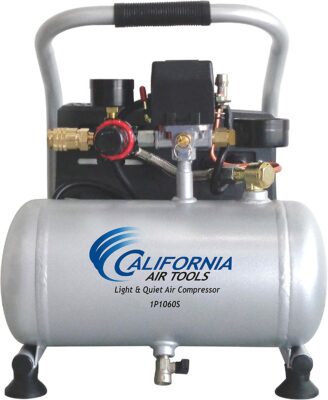
Editor’s Rating:
At a Glance
- Motor: 0.6 HP Corded Electric
- Pump: Oil-Free
- Pressure: 120 PSI Maximum
- Tank Size: 1-Gallon
- Air Delivery: 1.2 CFM @ 90 PSI
This is the quietest small air compressor in our lineup at just 56 dB. There’s no need for hearing protection due to how quiet it is, and you can even have a conversation close by without the sound of your voice being drowned out. That makes it ideal for home use or for use in the early hours without waking the whole neighborhood.
While it isn’t as powerful as the California Air Tools 2010A, it will be sufficient for most small tasks, like tire inflation and blowing out dust. The tank is also pretty small, but it only takes a minute to fill from empty. Coupled with the fact that it has a short recovery time, it’ll be enough for smaller jobs.
The design provides good stability, especially on smooth surfaces. This is because of the four large rubber suction cup feet. Unlike some of the other air compressors, this one isn’t going anywhere. The feet keep it anchored down no matter where you use it.
We should mention that there are small metal beads in the tank when you open it the first time. Why exactly, we don’t know. Be sure to open the drain valve and remove them before use. If left inside, they can cause damage to the pressure regulator and seize the pump.
This is a great small air compressor if you’re only doing light jobs and need something that’s quiet. If you need a compressor with more power and noise isn’t an issue, we’d opt for the powerful Makita MAC2400 Big Bore.
Pros
- Ultra-quiet at only 56 dB
- Quick recovery times
- Great design with suction cup feet
- Ideal for small home tasks
Cons
- Not the most powerful with low air delivery
- Small tank runs out quickly
6. Best Cordless: Dewalt Flexvolt Cordless Air Compressor Kit
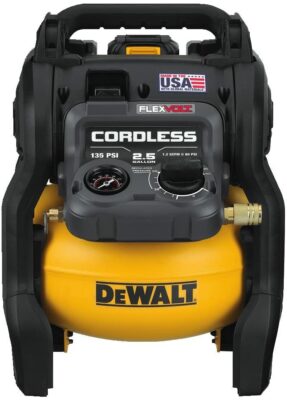
Editor’s Rating:
At a Glance
- Motor: 0.4 HP Cordless Electric Battery
- Pump: Oil-Free
- Pressure: 135 PSI Maximum
- Tank Size: 2.5-Gallons
- Air Delivery: 1.2 CFM @ 90 PSI
The Dewalt Flexvolt is unique to our list as it’s a cordless electric air compressor. It uses a 6Ah battery for power, which, to be honest, is a little lackluster as it drains too quickly. The good news is that you can purchase a 9Ah battery that provides more power for longer running times. And as it comes in a 2-pack, once the battery is dead, you can simply switch it over.
If you plan on using the compressor for long periods of time, it might not be the right one for you. Instead, any of the other corded electric compressors on our list will be better, as they don’t have the limitation of batteries.
Being battery powered means there’s no need for an outlet, so you can use it in many more places, such as the outdoors. It also comes with a rapid charger that takes around 1 hour to fully charge the battery.
The tank is a decent size considering it weighs just under 22 pounds. While it isn’t the most powerful air compressor out there, it is designed for convenience and portability. The extra convenience comes at a cost to its recovery and running times, though.
To fill the tank from empty takes roughly 2 minutes, and just half a minute to reach 135 PSI from 100 PSI. Its air delivery is higher than the Senco PC1010, but the Flexvolt is more expensive and marginally heavier.
The controls are easy to use, with a single pressure gauge and easy to use pressure regulator. Simply turn it to your desired pressure and away you go. The on/off switch is sealed to prevent dust ingress and it has a protective hood, which is useful if you’re using it in a dusty environment.
Dewalt is a great brand and their products are high quality and made in the USA. This is a great air compressor if portability and convenience are your main priorities.
Pros
- Battery-powered means no outlet required
- The 2.5-gallon tank fills quickly
- Lightweight and highly portable
- Dewalt is a trusted brand
Cons
- Recovery times are longer
- Sacrifices air delivery for convenience
7. Most Portable: Porter-Cable Air Compressor Kit
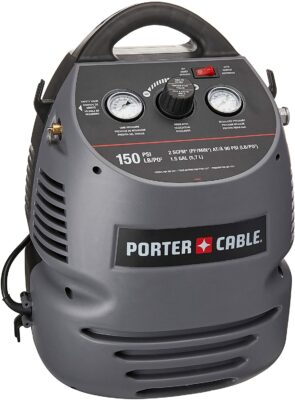
Editor’s Rating:
At a Glance
- Motor: 0.8 HP Corded Electric
- Pump: Oil-Free
- Pressure: 150 PSI Maximum
- Tank Size: 1.5-Gallons
- Air Delivery: 2 CFM @ 90 PSI
The Porter-Cable air compressor kit is the lightest and most portable air compressor on our list, weighing just 20 pounds. However, it is fairly noisy at 79 dB. If that’s too loud for you, you may want to consider the much quieter California Air Tools 2010A Ultra Quiet as it has very similar specs.
For its size and weight, it offers excellent performance. It’s more powerful than many of the other compressors of a similar size, but our biggest concern with this compressor is the design; while it does have small rubber feet, they don’t do a good job of keeping the machine upright, as its center of gravity causes it to topple over easily. If you’re going to use it standing up, it’s probably best to place it against a wall.
The fully enclosed design protects the unit from dust or dirt, while the air vents help dissipate heat buildup. In addition to that, the design is clean and easy to use with two gauges, an on/off switch, and a pressure regulator. The hose connector is conveniently located on the side of the unit for easy access.
This would be a great small compressor for taking with you in an RV, as it can be easily stored away. It has a low 10-amp draw, making it ideal for hooking up to a generator and inverter for topping up truck, RV, or bike tires.
Pros
- Lightweight at just 20 pounds
- Excellent performance for its size
- Unit is fully enclosed for protection from dust
Cons
- Prone to toppling over
- Fairly noisy at 79 dB
8. Honorable Mention: California Air Tools Ultra Quiet Air Compressor
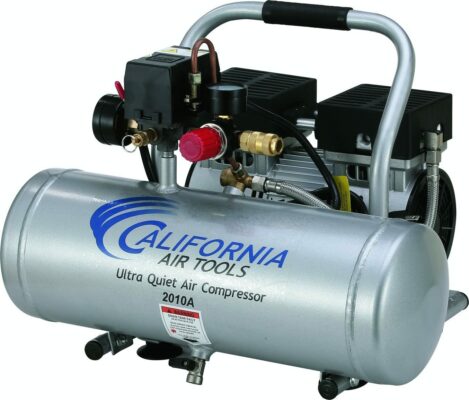
Editor’s Rating:
At a Glance
- Motor: 1 HP Corded Electric
- Pump: Oil-Free
- Pressure: 120 PSI Maximum
- Tank Size: 2-Gallons
- Air Delivery: 2.2 CFM @ 90 PSI
The California Air Tools 2010A is another super quiet air compressor, with a decibel rating of just 60 dB. It isn’t as quiet as the California Air Tools Light & Quiet but it’s not far off. It has a good-sized 2-gallon tank that fills from empty in just under 60 seconds and from 80 to 120 PSI in just 15 seconds, so there’s little waiting time between refills.
This hotdog style compressor has a wide frame and rubber feet to dampen vibrations, regardless of the surface it’s placed on. It’s also less likely to topple over as it has enhanced stability due to the hotdog design. It features an aluminum tank, which is handy as aluminum doesn’t rust, even if you forget to drain the tank. It does have a drain valve at the bottom, and we’d recommend opening it after each use to avoid moisture buildup.
The power cord is pretty short at just 4 ft, however, it can be used with a heavy-duty extension cord. The pressure gauge is in an awkward position to the left of the machine. However, the regulator is well-positioned and easy to use with a pressure adjustment knob located just below.
If you’re after a quiet air compressor with quick recovery times and good air delivery, the 2010A does the job well.
Pros
- Quiet 60 dB operation
- Wide frame provides better stability
- Quick refill times in under 60 seconds
- Aluminum tank prevents rusting
Cons
- Short power cord
- Awkward gauge position
9. Most Powerful Oil-Free Compressor: Bostitch Air Compressor for Trim
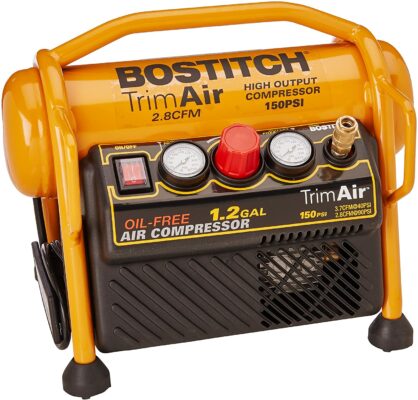
Editor’s Rating:
At a Glance
- Motor: 1.5 HP Corded Electric
- Pump: Oil-Free
- Pressure: 120 PSI Maximum
- Tank Size: 1.2-Gallons
- Air Delivery: 2.8 CFM @ 90 PSI
While this Bostitch air compressor isn’t the most powerful on our list (that honor goes to the Makita MAC2400), it is the most powerful oil-free air compressor. Its 1.5 HP motor is capable of delivering 2.8 CFM @ 90 PSI, which is slightly more than Bostitch’s pancake style compressor.
Design-wise this small air compressor is very sturdy, with a solid roll cage protecting the unit from accidental damage. It also has good quality rubber feet that help keep it stable and vibration-free, no matter what type of surface you use it on. There’s also a handy cord wrap, which makes storing it away nice and easy.
This air compressor was primarily designed for use with trim guns. However, it’s capable of performing other small tasks, such as tire inflation. We wouldn’t recommend it for big jobs, though, especially considering the small tank size. For bigger jobs that require a larger tank, take a peek at the excellent Craftsman Compressor + Accessory Kit.
The clear controls at the front make it very easy to use, even for first-time users. It has an on/off switch, connector, pressure and tank gauges, and a pressure regulator knob.
Overall this is a fairly powerful air compressor with a great design. It’s priced well for what it does, and it’s light enough to carry around.
Pros
- Most powerful oil-free air compressor
- Sturdy design with a solid roll cage for protection
- Easy to use controls
Cons
- Not suitable for heavy-duty tasks
10. Best Vibration Dampening: Rolair JC10 Plus 1 HP Air Compressor
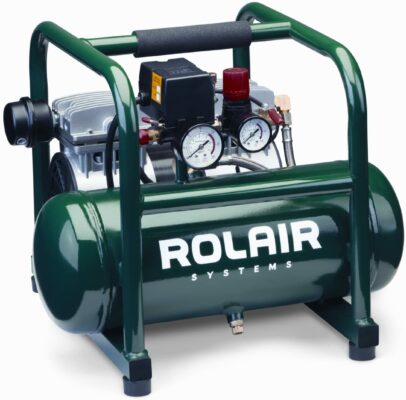
Editor’s Rating:
At a Glance:
- Motor: 1 HP Corded Electric
- Pump: Oil-Free
- Pressure: 125 PSI Maximum
- Tank Size: 2.5-Gallons
- Air Delivery: 2.4 CFM @ 90 PSI
The Rolair JC10 Plus is a small, quiet, but fairly heavy air compressor. Considering its size and horsepower, the JC10 has excellent air delivery, offering 2.4 CFM @ 90 PSI. In addition to that, the 2.5-gallon tank can hold a lot of compressed air, resulting in longer tool running times.
This hotdog air compressor is very well built with a large frame protecting the tank, motor, and pump. In addition to having chunky rubber feet for enhanced stability and vibration dampening, the compressor itself is mounted to the frame using rubber. This further improves vibration dampening and stops the compressor from moving about.
At just 60 dB this is a very quiet air compressor, in part thanks to its muffler and filter. The filter also keeps dust out of the pump and motor, prolonging its lifespan. If you’re using it in a dusty environment, it’s a good idea to regularly change the filter to avoid any potential issues.
The coupler, power switch, and gauges are all easy to access, although the gauges are in an awkward position. To read them properly, you have to stoop down; from a design perspective, they’d be better facing upwards, but it’s not a deal-breaker.
All in all, this is a good choice for everyday light tasks. If you need an air compressor with a bit more oomph, you may want to consider the premium Makita MAC2400 2.5 HP Big Bore. We feel this is a decent small air compressor, albeit a little expensive.
Pros
- Very well built with a large frame and rubber mounts
- Muffler and filter make it quiet at just 60 dB
- Great air delivery considering its size and horsepower
Cons
- Not the best value for money
- Gauges are in an awkward position
Everything You Need to Know About Small Air Compressors
If you’re still not sure about which air compressor to buy, then fear not. In this section, we’ll look at everything you need to know about small air compressors in more detail.
Pounds per Square Inch (PSI)
PSI stands for pounds per square inch, which is a measurement of the air pressure the compressor can generate and hold within the tank. This is important, as most tools require at least 90 PSI to function, and more power-hungry tools will need more.
It’s important to note that quoted PSI figures are often the maximum pressure the tank can hold, which means it may be lower during prolonged periods of use. This means that you may want to choose a compressor with a slightly higher PSI than the tools you’re using to account for the drop in pressure.
Cubic Feet per Minute (CFM)
CFM stands for cubic feet per minute, which is the amount of air the compressor can deliver in one minute. This is perhaps the most important metric to look out for, and it’s the best one to use when comparing the performance between air compressors.
The CFM rating differs based on the operating pressure, so the best way to compare is at 90 PSI, which is what we’ve done in all of our product reviews. If you do come across a compressor that doesn’t display the CFM rating, you can easily calculate it yourself by following these steps.
Small jobs, such as stapling or nailing, require a low CFM, as the tank is able to refill between each staple or nail. Spray painting, on the other hand, requires a longer, continuous airflow, which means a higher CFM is needed.
Horsepower (HP)
The horsepower is an indication of how powerful the motor is. Many manufacturers will list the peak horsepower, which is only achieved when the motor starts up and lasts for just a fraction of a second before dropping off.
While horsepower is a useful metric to look at when comparing larger and more powerful air compressors, for small air compressors, it’s not that useful. It’s better to compare power by looking at the air delivery (CFM) and maximum pressure (PSI) numbers.
Tank Size
The compressor’s tank size is important, as it determines how long air tools can run before the motor has to kick in and generate more compressed air. A larger tank, such as the one seen in the 6-gallon Craftsman, means longer tool running times. This also has an effect on the longevity of the motor, as a motor that has to keep compressing air regularly due to the tank being small will wear out a lot quicker.
Smaller tanks, from 1 to 6 gallons, will be sufficient for most small home DIY jobs. However, for larger jobs, such as spray painting or sanding, you may need a bigger tank ranging from 10 to 60 gallons. Unfortunately, such a large tank means the compressor is big and heavy, which isn’t ideal for storing at home or moving about regularly.
Oil-Lubricated vs. Oil-Free Pumps
There’s a common misconception that oil-free air compressors don’t use oil. Both oil-free and oil-lubricated pumps have pistons that require oil to function properly. The key differences between to two are:
- Oil-free pumps are pre-lubricated and sealed from the factory. This lubrication should last the lifespan of the compressor, requiring no maintenance from the user.
- Oil-lubricated pumps require routine maintenance in the form of adding oil. These pumps are longer lasting and are often seen in more powerful compressors, such as the Makita MAC2400 or gas-powered air compressors.
The right option for you will depend on whether you’re comfortable taking the pump apart and adding oil yourself. If you’re a light user, we’d recommend sticking to oil-free as they’re less hassle. However, if you’re a heavy or regular user, an oil-lubricated pump will last longer.
Gas Motor vs. Electric Motor
Gas-powered motors are more powerful than their electric counterparts, resulting in greater horsepower, PSI, and CFM ratings when compared to electric motors. The downside is that they’re a lot heavier, bigger, and noisier. They’re also more expensive. You only need a gas-powered air compressor for heavy-duty tasks or for use in an industrial setting.
Most electric motors need to be plugged in, but some, like the Dewalt Flexvolt have batteries that allow them to be used without an outlet, which is good for using outdoors. Electric compressors are a lot smaller, lighter, and quieter than their gas counterparts. They’re also a lot cheaper.
The drawback here is that they’re not as powerful, with lower horsepower, CFM, and PSI. That won’t be an issue for small to medium-sized jobs, though, such as DIY projects or inflating tires.
Different Types of Air Compressors
There are three main types of air compressors, each with a slightly different design. These different designs affect their stability and how well the motor is protected. The three designs are as follows:
Pancake Air Compressors
Pancake air compressors are round and flat, with the motor and pump located on top. This design provides better stability, especially if the feet are rubber-coated. They’re smaller in size, light, and easy to store and carry.
The only downside is that the tanks are typically smaller in size, although there are some larger pancake-style compressors, like this one by Bostitch.
Hot Dog Air Compressors
Hot dog air compressors have a single tank that sits horizontally. These are typically larger and heavier than pancake air compressors, although that’s not always the case, as seen with the small and lightweight Senco PC1010.
The key benefit of this design is that they usually have a roll cage that protects the motor, pump, and tank, making them better suited for use in environments where they could be damaged.
As these air compressors are usually wider with a lower center of gravity, they’re more resistant to vibrations, meaning they have greater stability and move around a lot less.
Twin-Stack Air Compressors
Twin-stack air compressors are similar to hot dog compressors, but they have two air tanks placed on top of each other. The great thing about twin-stack compressors is that they have a larger air capacity while still remaining small in size.
The Makita MAC2400 is an example of a twin stack air compressor. As you can see, it has a large air capacity while remaining small and portable.
Finishing Up
By this point, you should have a better understanding of the most important things to look out for when buying a small air compressor. Compared to buying a regular air compressor, there are plenty of additional things to think about, such as size, weight, and design.
A small air compressor naturally gives up some power and tank capacity in order to be small, lightweight, and portable, but that’s not a major issue for people doing small jobs at home.
Regardless of what you’re going to use the compressor for, there’s one to suit everybody’s needs on our carefully selected list of the ten best small air compressors.
